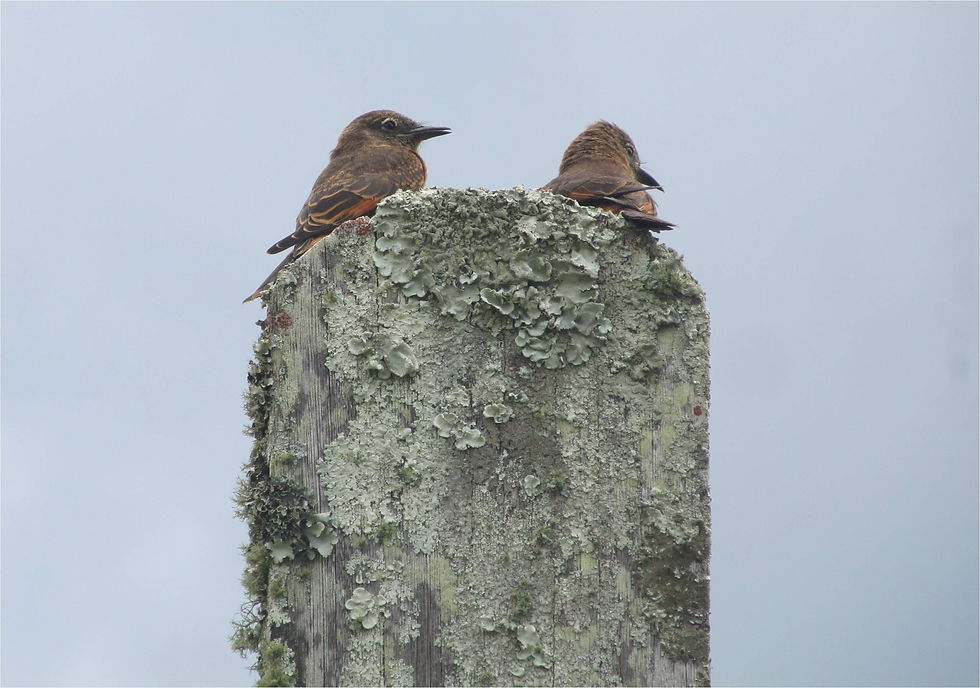5 tips for a good birdwatching
- larissabrazsousa
- Sep 18, 2020
- 4 min read
Updated: May 16, 2021
Bianca Darski Biologist, Ornithologist and Ph.D. in Ecology
So, who’s keen to go birding?
“Birdwatching or just birding” is the act of observing birds in nature. An unusual verb in grammar, but common among passionate birders. To ensure a good birding, check it out the five tips below:
1) Bird time
Birds have two peaks of activity that allow us to observe them more easily. Early morning is the best time, but in the late afternoon, it is also possible to find them easily. Many birds start to sing as soon as the sun rises and again when the sun goes down. But these times are not always the best, especially when the day starts with that light rain, but soon after that bright sun comes out. You can be sure that the birds will begin to sing as soon as the sun comes up!

PHOTO: Flock of snowy egrets in the evening at Barra de Ibiraquera, Imbituba, SC, Brazil.
2) Neutral clothing
Birds recognize colours very well and so, to neither be seen nor scare the birds, it is important to choose clothes with colours that make you more similar to the surrounding environment, that is, camouflaged.

In general, brown shades and green or grey tones work very well for birdwatching in different environments.
PHOTO: The ideal clothing is one that makes you go unnoticed like this moth on a tree trunk in the Atlantic Forest, Brazil.
3) Photo camera and binoculars
Nowadays, having a camera is much more affordable than it was ten years ago. We can take amazing pictures using mobile phones and still take advantage of the internet and GPS to post our field observations with a precise location on social networks. Often the camera replaces the main equipment of a birdwatcher: the binoculars. Binoculars are equipped with lenses that can magnify, on average, ten times the image we are observing and are excellent for seeing details, such as those feathers around the eyes of the bird that is perched on the top of the pole. Professional and semi-professional cameras (those with wide-ranging zoom) also allow us to observe these details.

Don't worry. It's not essential to have binoculars or a professional camera to make excellent bird records. Most birds, especially in urban areas and parks, can be seen with the naked eye and photographed with a mobile phone.
PHOTO: Ciff flycatcher in the Atlantic Forest, Ibitipoca, MG, Brazil.
4) Something to take notes
It can be a notebook and a pencil or even your mobile phone. Unfortunately, our memory does not keep all the information we would like; therefore, it is worth taking notes about the details of our observations. Note, for example, the colours of the bird's beak and legs, what was its song like (pupupu or tititititi?), If it was alone or in a flock, if it looked like a young individual or adult, if it was eating something or just perched watching the landscape (like you!).

If you visit the same place several times, it may be useful to take notes about the weather conditions of each day, if it was cloudy, sunny, raining, in addition to the date of the observations. Photographs are excellent for recording birds, in addition to the day and time of observation. Still, some details can't be photographed, and the act of taking notes helps to fix the information in our memory.
PHOTO: Biologists taking notes about birds in the Atlantic Forest, Maquiné, RS, Brazil.
5) Field guides and identification tools
Bird identification guides are traditionally in book format. In these guides, you can find illustrations of bird species, as well as the place where they reside and other detailed information. The main limitation of traditional guides is their lack of practicality. We won't always have the perfect guide for the place where we will go birding. For example, you can have a Peru bird guide, which is very useful in Peru and the surrounding area. But if you live in Brazil, in São Paulo, you will see that the bird species will not be the same as those in Peru (although you may find some common species).

That is because the area of distribution – that is, the place where individuals of a species of bird reside and breed – can be very wide, such as all Latin America, or more restricted, like just the state of São Paulo.
PHOTO: Bird identification guides.
Don't worry if you don't have a traditional bird guide. Technology allows us to identify bird species, as well as discover other detailed information, not just about birds. There are several species identification guides in digital format, and you can download specific bird apps, such as Merlin, or more general, as iNaturalist. With these apps, it becomes effortless to recognize these feathered species and learn more about them.
Now that you know the main tips on excellent birdwatching, schedule yourself in the birds time, choose the ideal clothing style to go unnoticed, separate your notebook and pencil, mobile phone or camera and/or binoculars.
Ready. Have a good birding!




Kommentare